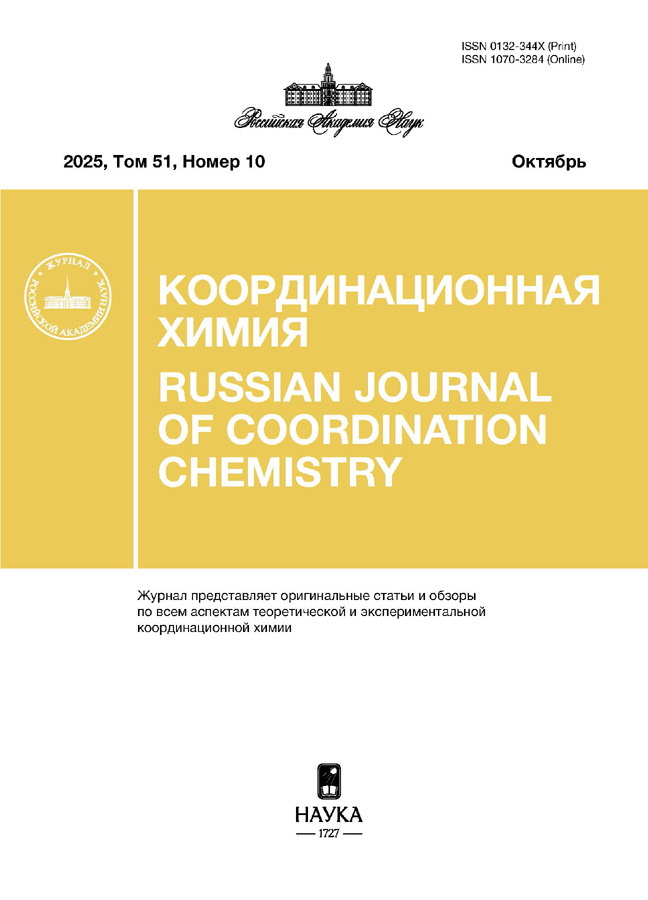Heterometallic manganese(III) coordination polymers with Schiff bases (H2Salpn) and dicyanometallates
- Authors: Kopotkov V.A.1, Zorina L.V.2, Simonov S.V.2, Utenyshev A.N.1, Bozhenko K.V.1
-
Affiliations:
- Federal Research Center for Problems of Chemical Physics and Medicinal Chemistry, Russian Academy of Sciences
- Osipyan Institute of Solid State Physics, Russian Academy of Sciences
- Issue: Vol 51, No 4 (2025)
- Pages: 255-264
- Section: Articles
- URL: https://gynecology.orscience.ru/0132-344X/article/view/679430
- DOI: https://doi.org/10.31857/S0132344X25040059
- EDN: https://elibrary.ru/LPDIAF
- ID: 679430
Cite item
Abstract
Single crystals of the Mn(III) complexes with tetradentate (N2O2) Schiff bases (L) and dicyanometallates [Mn(L)M(CN)2]n, where L = Salpn2– = N,N’-bis(salicylidene)-1,3-diaminopropane, M = M = Ag+ (I), Au+ (II) were obtained for the first time. The molecular structures of I and II were determined by X-ray diffraction (CCDC no. 2351118 (I), 2351119 (II)). It was found that the dicyanometallate anion [M(CN)2]ˉ in the crystal structure of these compounds acts as a bridge binding the Mn(III) moieties with the Schiff base into 1D. Using quantum chemical calculations, the (3, –1) type critical points were found near the C‒H…Ag/Au contact; this attests to the existence of weak hydrogen bonds between these atoms.
Full Text
About the authors
V. A. Kopotkov
Federal Research Center for Problems of Chemical Physics and Medicinal Chemistry, Russian Academy of Sciences
Author for correspondence.
Email: vakopotkov@icp.ac.ru
Russian Federation, Chernogolovka, Moscow oblast
L. V. Zorina
Osipyan Institute of Solid State Physics, Russian Academy of Sciences
Email: vakopotkov@icp.ac.ru
Russian Federation, Chernogolovka, Moscow oblast
S. V. Simonov
Osipyan Institute of Solid State Physics, Russian Academy of Sciences
Email: vakopotkov@icp.ac.ru
Russian Federation, Chernogolovka, Moscow oblast
A. N. Utenyshev
Federal Research Center for Problems of Chemical Physics and Medicinal Chemistry, Russian Academy of Sciences
Email: vakopotkov@icp.ac.ru
Russian Federation, Chernogolovka, Moscow oblast
K. V. Bozhenko
Federal Research Center for Problems of Chemical Physics and Medicinal Chemistry, Russian Academy of Sciences
Email: vakopotkov@icp.ac.ru
Russian Federation, Chernogolovka, Moscow oblast
References
- Сапьяник А.А., Федин В.П. // Коорд. химия. 2020. Т. 46. № 7. С. 387.
- Lawrance G.A. Encyclopedia of Inorganic Chemistry. John Wiley & Sons, Ltd., 2006. 22 p.
- Miyasaka H., Saitoh A., Abe S. // Coord. Chem. Rev. 2007. V. 251. P. 2622.
- Oki A.R., Hodgson D.J. // Inorg. Chim. Acta. 1990. V. 170. № 1. P. 65.
- Miyasaka H., Matsumoto N., Okawa H. et al. // Angew. Chem. Int. Ed. 1995. V. 34. P. 1446.
- Re N., Gallo E., Floriani C. et al. // Inorg. Chem. 1996. V. 35. P. 6004
- Sakamoto F., Sumiya T., Fujita M. et al. // Chem. Lett. 1998. V. 27. P. 1127.
- Miyasaka H., Clerac R., Ishii T. et al. // Dalton Trans. 2002. № 7. P. 1528.
- Paraschiv C., Andruh M., Ferlay S. et al. // Dalton Trans. 2005. № 7. P. 1195.
- Niel V., Thompson A.L., Munoz M.C. et al. // Angew. Chem. Int. Ed. 2003. V. 42. P. 3760.
- Shorrock C.J., Xue B.Y., Kim P.B. // Inorg. Chem. 2002. V. 41. P. 6743.
- Leznoff D.B., Xue B.Y., Batchelor R.J. // Inorg. Chem. 2001. V. 40. P. 6026.
- Leznoff D.B., Xue B.Y., Stevens C.L. et al. // Polyhedron. 2001. V. 20. P. 1247.
- Dong W., Zhu L.N., Sun Y.Q. et al. // Chem. Commun. 2003. № 20. P. 2544.
- Ashmawy F.M., McAuliffe C.A., Parish R.V., Tames J. // Dalton Trans. 1985. № 7. P. 1391.
- Fujisawa K., Nemoto T., Morishima Y. et al. // Molecules. 2021. V. 26. № 4. P. 1015;
- Накамото К. Инфракрасные спектры неорганических и координационных соединений. M.: Мир, 1966. 411 с.
- Sheldrick G.M. SADABS. Gőttingen (Germany): Univ. of Gőttingen, 1996.
- Sheldrick G.M. // Acta Crystallogr. A. 2008. V. 64. P. 112.
- Sheldrick G.M. // Acta Crystallogr. C. 2015. V. 71. P. 3.
- Frisch M.J., Trucks G.W., Schlegel H.B. et al. Gaussian 09., Revision C.01. Wallingford (CT): Gaussian, Inc., 2009.
- Koskinen L., Jääskelдinen S., Kalenius E. et al. // Cryst. Growth. Des. 2014. V. 14. P. 1989.
- Schmidbaur H., Raubenheimer H.G., Dobrzaсska L. // Chem. Soc. Rev. 2014. V. 43. P. 345.
- Andris E., Straka M., Vrána J. et al. // Chem. Eur. J. 2023. V. 29. P. e202203769.
- Keith T.A. AIMAll. TK Gristmill Software. Version 15.05.18. Overland Park, KS, USA, 2015. aim.tkgristmill.com
- Clark T., Murray J., Politzer P. // Phys. Chem. Chem. Phys. 2018. V. 20. P. 30076.
- Miyasaka H., Clerac R., Wernsdorfer W. et al. // Angew. Chem. Int. Ed. Eng. 2004. V. 43 № 21. P 2801.
- Feng Y., Guo Y., OuYang Y. et al. // Chem. Commun. 2007. № 35. P. 3643.
- Lusi M., Barbour L.J. // Cryst. Growth. Des. 2011. V. 11. P. 5515;
- Wang X.-B., Wang Y.-L., Yang J. et al. // J. Am. Chem. Soc. 2009. V. 131. P. 16368.
- Nastase S., Maxim C., Duhayon C. et al. // Rev. Roum. Chim. 2013. V. 58. P. 355.
- Ababei R., Li Y.-G., Roubeau O. et al. // New J. Chem. 2009. V. 33. P. 1237.
- Si S.-F., Tang J.-K., Liu Z.-Q. et al. // Inorg. Chem. Commun. 2003. V. 6. P. 1109.
- Kopotkov V.A., Sasnovskaya V.D., Korchagin D.V. et al. // CrystEngComm 2015. V. 17. P. 3866.
- Kopotkov V.A., Yagubskii E.B., Simonov S.V. et al. // New J. Chem. 2014. V. 38. P. 4167.
Supplementary files














